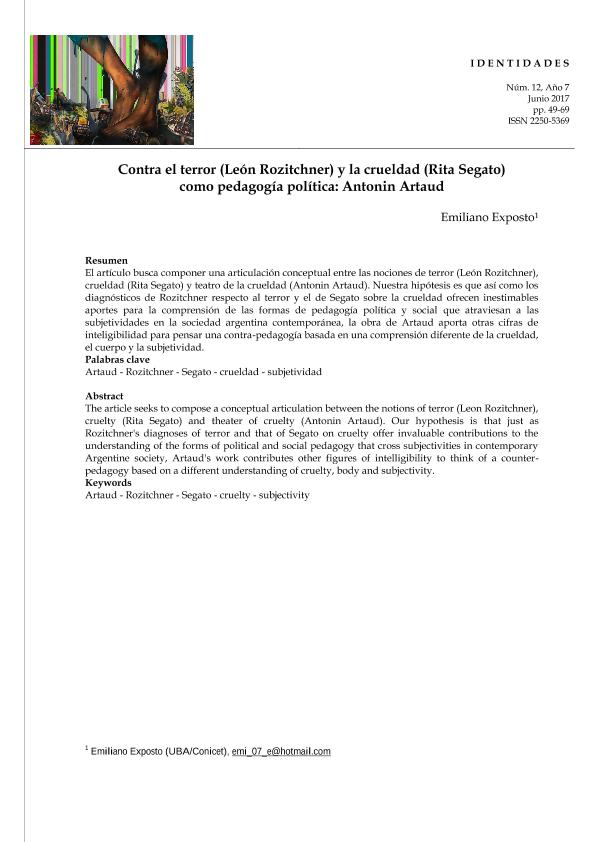Artículo
El artículo busca componer una articulación conceptual entre las nociones de terror (León Rozitchner), crueldad (Rita Segato) y teatro de la crueldad (Antonin Artaud). Nuestra hipótesis es que así como los diagnósticos de Rozitchner respecto al terror y el de Segato sobre la crueldad ofrecen inestimables aportes para la comprensión de las formas de pedagogía política y social que atraviesan a lassubjetividades en la sociedad argentina contemporánea, la obra de Artaud aporta otras cifras de inteligibilidad para pensar una contra-pedagogía basada en una comprensión diferente de la crueldad, el cuerpo y la subjetividad. The article seeks to compose a conceptual articulation between the notions of terror (Leon Rozitchner), cruelty (Rita Segato) and theater of cruelty (Antonin Artaud). Our hypothesis is that just as Rozitchner's diagnoses of terror and that of Segato on cruelty offer invaluable contributions to the understanding of the forms of political and social pedagogy that cross subjectivities in contemporary Argentine society, Artaud's work contributes other figures of intelligibility to think of a counterpedagogy based on a different understanding of cruelty, body and subjectivity.
Contra el terror (León Rozitchner) y la crueldad (Rita Segato) como pedagogía política: Antonin Artaud
Fecha de publicación:
07/2017
Editorial:
Instituto de Estudios Sociales y Políticos de la Patagonia
Revista:
Identidades
ISSN:
2250-5369
Idioma:
Español
Tipo de recurso:
Artículo publicado
Clasificación temática:
Resumen
Palabras clave:
Artaud
,
Rozitchner
,
Segato
,
Subjetividad
Archivos asociados
Licencia
Identificadores
Colecciones
Articulos(INSTITUTO "DR. E.RAVIGNANI")
Articulos de INST. DE HISTORIA ARGENTINA Y AMERICANA "DR. EMILIO RAVIGNANI"
Articulos de INST. DE HISTORIA ARGENTINA Y AMERICANA "DR. EMILIO RAVIGNANI"
Citación
Exposto, Emiliano; Contra el terror (León Rozitchner) y la crueldad (Rita Segato) como pedagogía política: Antonin Artaud; Instituto de Estudios Sociales y Políticos de la Patagonia; Identidades; 12; 7-2017; 49-69
Compartir




